Please use the following link to download the July 5, 2025 issue of the syəcəb
Author: Kim Kalliber
Beyond degrees and diplomas: College grads hope to put education to use for Tribe and community
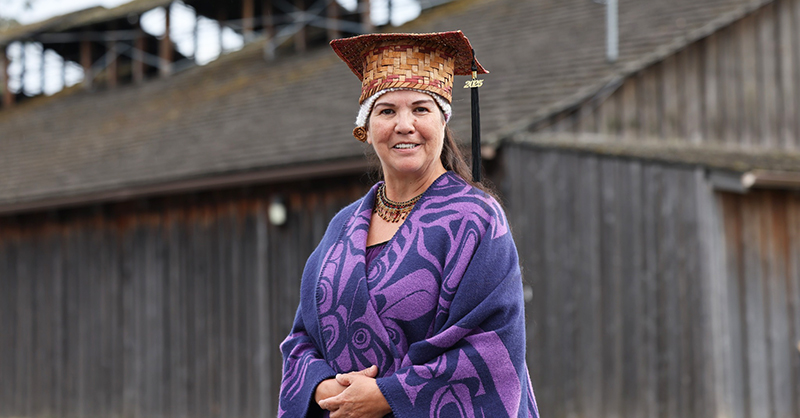
By Micheal Rios, Tulalip News
On Thursday, June 26, the latest iteration of Tulalip’s Higher Education grad banquet was hosted at a fancified Gregg Williams Court. Thirty college graduates were celebrated for achieving a monumental milestone and invited to attend a banquet in their honor, surrounded by community supporters on their ancestral homelands.
Recently elected Board of Director Deb Parker served as event emcee. “My hands go up to each and every one of you here to support our graduates. As I was sitting here reflecting, I couldn’t help but think of when I graduated Marysville Pilchuck High School many, many years ago, and was only 1 of 5 tribal members pursuing higher education. If you think of how far we’ve come as a Tribe since then, to now having so many tribal members attending colleges all across the country, and even a couple outside of the country, it’s actually quite remarkable. You all, our graduates, are remarkable.
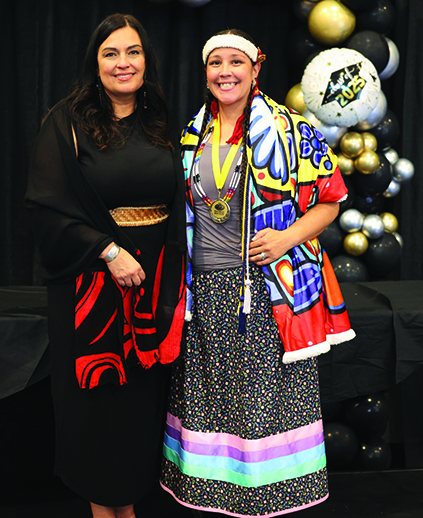
“When I was attending the University of Washington, my elder Ray Moses told me, ‘We are so proud of you. Keep doing the best that you can, and when you’re finished getting your education, you come back and serve your Tribe’,” continued Deb. “I now have the honor of serving my Tribe as a Board of Director and sharing that same message with all of you. We need your education and your skills to take us into the future. Like our ancestors who laid the foundation for us to walk today, we need you to continue striving for and building new pathways so future generations can run and even soar.”
Deb’s opening remarks were met with a rousing ovation from college grads and community supporters who share the late, great Ray Moses vision for putting education to service for our Tribe. Routinely, attending banquet graduates echoed their appreciation for all Tulalip has done for them, including the significant financial assistance for tuition, housing, and life expenses that afforded many the opportunity to pursue their higher education dreams. They also echoed an intent desire to now return home and join the Tulalip workforce.
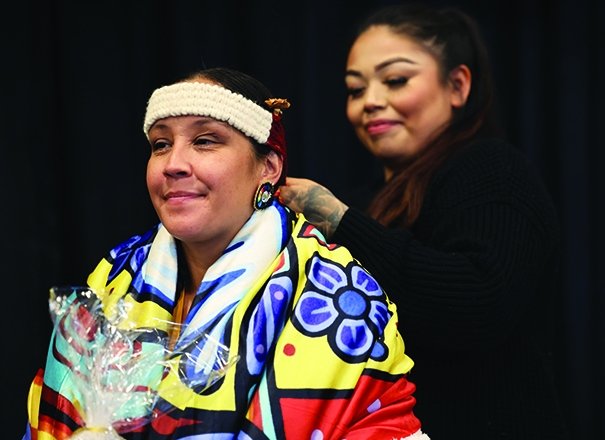
Student speaker Dinesha Kane just recently returned from Georgia, where she played golf on the collegiate stage while earning her Bachelor of Business Management degree from Northwest Indian College.
“In just one year, I completed my Associate’s and Bachelor’s degrees while carrying a course load that many called impossible at two colleges,” stated Dinesha from the podium. “I did this while raising my two incredible sons – Brodie, my oldest, and Braiden, my youngest – who inspire me every single day with their laughter, their brilliance, and their love. I did this with the unwavering support of my husband JT, who never let me forget my power, even in the moments when I doubted it myself.
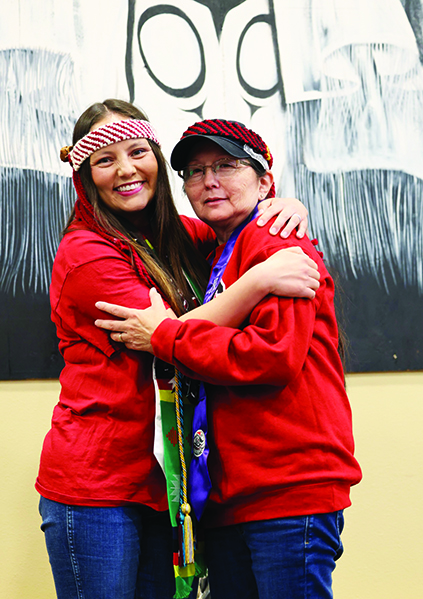
“Every class I took, every page I turned, every paper I wrote—I did it for them. For my family. For my community. For every young Indigenous student who has ever wondered if they belong in these spaces. I am here to say—you do. We do. We always have.
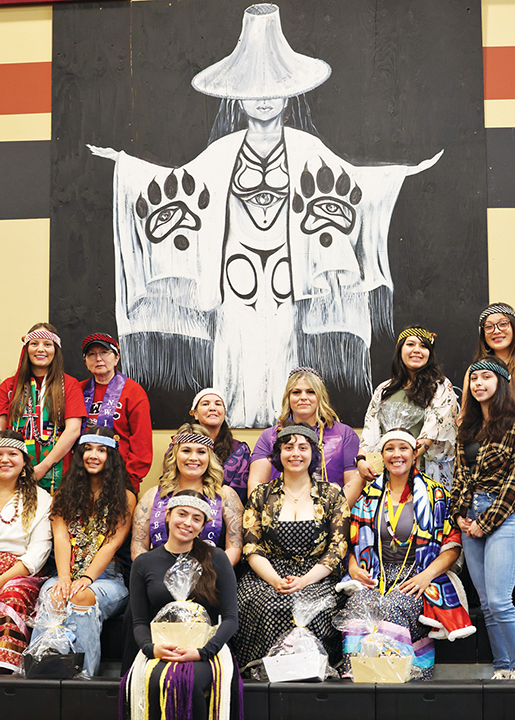
“And if there’s one thing I’ve learned through all of this, it’s this: Don’t be afraid to fall. Don’t be afraid to make mistakes, to stumble, to not have it all figured out. Fall—and then get back up. And if you fall again? Get up again. Every setback, every misstep, every late night filled with doubt and tears—it’s all part of becoming. Growth doesn’t happen in comfort zones. Strength doesn’t come from things being easy. It comes from rising every time life tries to knock you down. Keep trying. Keep showing up. That’s how we win.”
Awarded highest honors valedictorian, Dineshia is hopeful she’ll be able to put everything she’s learned into benefitting Tulalip’s youth as a sports psychologist. We wish her nothing but the best in her future endeavors.
Meanwhile, fellow student speaker James Whitebear has already carved out quite the roll for himself in his Tribe. After graduating high school in 2010, he soon joined Tulalip’s working class. Fourteen years later, James thrives in his role as Category Coordinator for Tulalip Tribal Federal Corporation, where he specializes in marketing and category management. Along the way he made a promise to his mom that he’d go to college and get a degree. After his mom passed in 2019, James made it a priority to fulfill that promise.
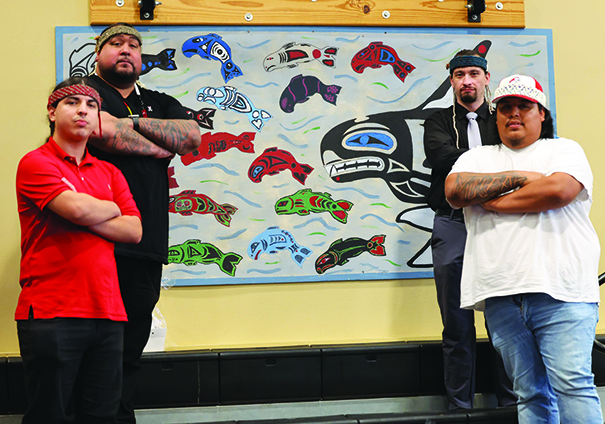
“She may not be here today to see this moment, but every single step that I took, every single assignment I completed, my mom was there with me, guiding me and seeing me through the process,” James shared. “Now, I’m here sharing in this sacred moment with all my fellow graduates. So whether you earned an A.A., a B.A., a Master’s or Ph.D., we are not defined simply by those letters next to our name, but by the legacy we are striving to build for generations to come.
“Make no mistake, this academic journey was not just for you or your immediate family. You carry your great-grandmothers and great-grandfathers who weren’t allowed to speak their language or practice their culture. You carry great-uncles and great-aunties who couldn’t leave the Reservation or get a job because they were too Indian. You honor all those who walked before us by telling your story today, loudly and proudly, and by refusing to be silenced.
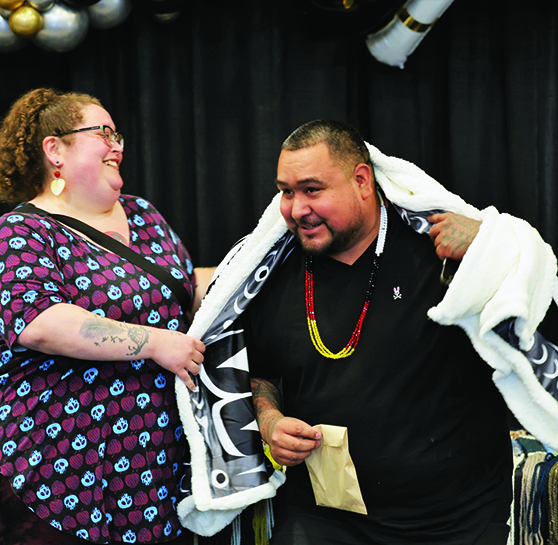
“Now, some of you may wonder what’s next after graduation and what do to with your degrees,” James addressed. “The answer is simple. Now, we build. Now, we teach. And, now, we lead. We need you to return home to Tulalip with open hearts and open minds, for our youth and our shared future.”
The wisdom in Ray Moses’ vision for his people to go to college, get all the education they can, and then bring it back in service of their Tribe, is a call to action that this most recent crop of higher education graduates is committed to answering.
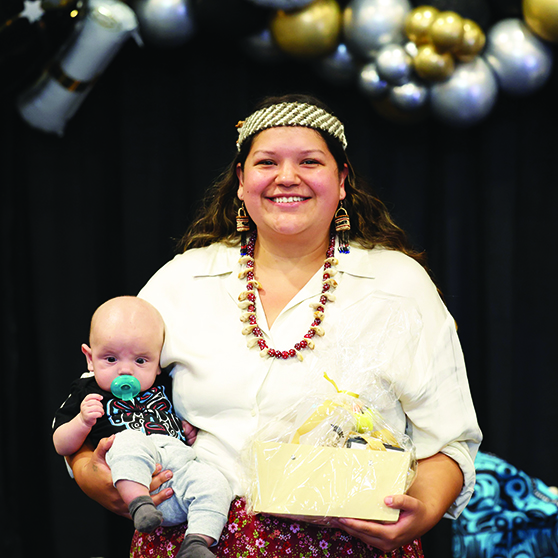
If you feel empowered to also answer the call, please contact Higher Education at (360) 716-4888 or email highereducation@tulaliptribes-nsn.gov Tulalip’s Higher Ed staff are eager to help new and returning students find their path to academic success. They can assist with FAFSA applications and finding scholarship opportunities, as well as simply reviewing the Tribe’s current policies regarding paying for college and other educational programs.
Tulalip triumphs over Angel of the Winds

By Micheal Rios, Tulalip News
In a spirited clash of local rival casinos turned community partners, staff members from Tulalip Resort Casino and Angel of the Winds Casino competed for a charitable cause – with all proceeds going to the Arlington Community Resource Center. It was a picturesque June evening when the two casino teams journeyed south to the iconic Husky Softball Stadium located on the University of Washington campus.

Leading up to this year’s game was constant chatter from team T.G.O. about how Angel of the Winds Casino won big in last year’s inaugural contest. Intent on avoiding another whooping at the hands of their rival, the local team practiced at the Youth Center’s ball field once a week for a month to establish everyone’s role and build team chemistry. They also recruited several new players who could potentially provide more power behind the plate. One such player was 48-year-old Tulalip tribal member Mike Contraro, who is known as something of a softball legend in his heyday.
“Honestly, this has been such a cool experience and really a great idea to get casino employees together outside of work,” shared Mike while getting his practice swings in pre-game. He’s spent decades at the Resort, most notably as Facilities/Engineering Director. “This is my first time at Husky Softball Stadium. My family traveled here, too, so they’re sitting in the bleachers and making the most of this experience, too. They’re more motivation for me to, hopefully, hit one out of the park.

“The recruiting pitch to me was pretty simple. They lost last year and I hate losing,” he added. “The goal is definitely to win this one and even up the rivalry at one game apiece.”
Following both teams pre-game stretching and on-field warmups, the stage was set for Tulalip’s chance at redemption in the home of the 2009 NCAA champion Huskies.

In the 1st inning, Tulalip took a 3-0 lead. To which Angels quickly responded by hitting a 2-run homerun and a solo shot in the bottom of the 1st to tie the game 3-3. The power display continued a couple innings later when Tulalip Resort valet Elliot Kaking belted a 3-run blast over the left field wall. Tulalip’s 6-3 lead was short-lived once again as Angels hit two 2-run homers in the bottom of the 3rd inning to take their first lead of the game.

Between the 3rd and 4th innings, we found T.G.O. player Kenneth Reedy thoroughly enjoying his view from the NCAA certified, Husky dugout. The 35-year-old Kenneth is enrolled in the Klamath Tribes of Oregon, but was raised on the Tulalip Reservation. In fact, he attended Quil Ceda Elementary and Heritage High School before joining the Tulalip Resort workforce. His workplace home for the past 17 years.
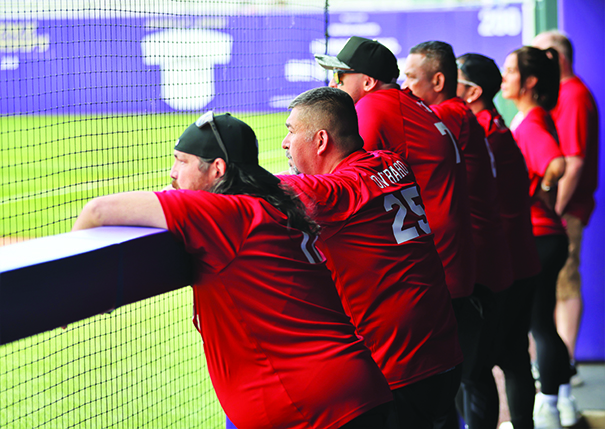
“Playing softball is a lot of fun. I usually play year-a-round and couldn’t pass up the opportunity to play on a casino team,” said Kenneth from his dugout perch. “We’ve come a long way from where we started as a team. It’s hard to get people with different skill levels and athletic ability to come together to complete a task like this, but we did it and had a lot of fun in the process.
“I’m just in awe that we are at UW, playing on their softball field and getting to be in their actual dugouts,” he continued. “This is a once in a lifetime opportunity.”
Back to the game. Angels led going into the 5th inning and their team was beginning to chirp with confidence that they’d win again. That chirping quickly ended after Tulalip hit another 3-run homerun, this time by information systems technician Rylee Chase-McGill. Injecting more life to the team was security officer Kekoa Castillo who followed that up with a solo homerun of his own.

Tulalip’s roaring comeback via the long ball ignited the team’s dugout and drew cheers from family and friends in the crowd.
Angel of the Winds briefly reclaimed the lead in the sixth, but Tulalip responded one final time in the top of the seventh. Melissa Hendren, T.G.O. hiring specialist, launched a towering two-run shot that ultimately secured a thrilling 14-12 win.
Players from both sides gathered at home plate after the game for handshakes and hugs, proving that while the rivalry is real, the shared purpose of sport, comradery and benefitting a local charity is even stronger.
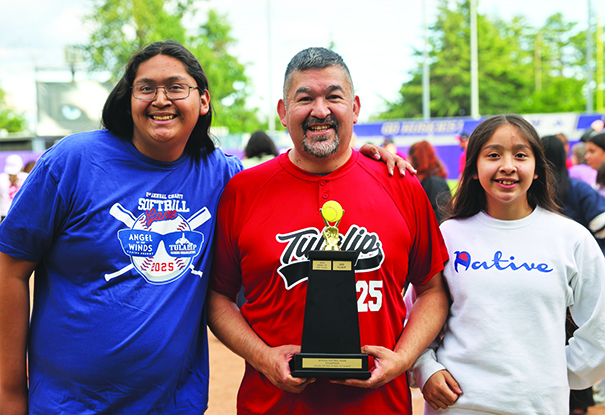
“We’re always looking for strategic ways to award our team members and to bring some fun into the work environment,” explained Wendy Fryberg, Tulalip Resort Executive Vice President of Administration, after her team’s winning effort. “We provided buses to transport our team members to the stadium, and so they could invite their families to attend and travel with them, too. I think my favorite part was giving our team members an opportunity to showcase their skills in this professional-type atmosphere. I overheard a number of kids rooting for their parents when they were at bat or got a hit. This was definitely a successful, family-friendly affair.”
Wendy’s point was made crystal clear by anyone who saw or was within earshot of Mike Contraro’s cheering section. His wife A.J. and their kids cheered loudly and proudly for him during each at bat and every fielding effort. His pre-game manifestation efforts to hit a homerun nearly came to be when he belted a ball to the left field wall. It looked to be gone off the bat, but came up just a few feet short and was caught on the warning track.
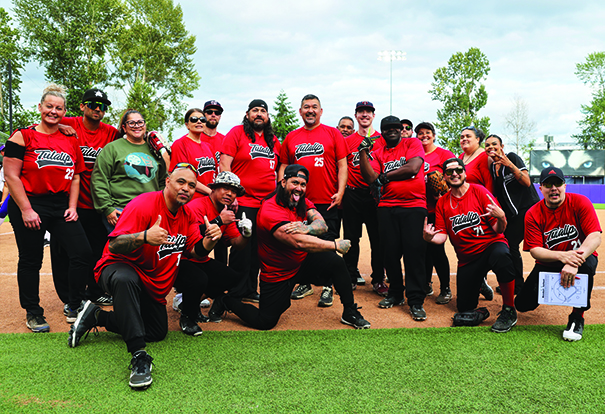
“I like “OHHHHH” and all excited thinking he hit a homerun,” admitted Mike’s 12-year-old daughter Charlie. “But it was just short. I’m still so happy he played because it’s been so long since he last played. It was important for me, my siblings, and our mom to be here and cheer him on. My dad has been to so many of my basketball games and is always rooting for me. It felt good to be able to root for him.”
Mike may not have gotten that home run in UW Softball Stadium, but he did get an unforgettable W. He also shared a special moment with his kids after they ran on to the field to celebrate Tulalip’s victory.
Both casinos confirmed plans to keep the charity game tradition going, hoping to draw even bigger crowds next summer.
‘Portraits in Red’ highlights Missing and Murdered Indigenous People
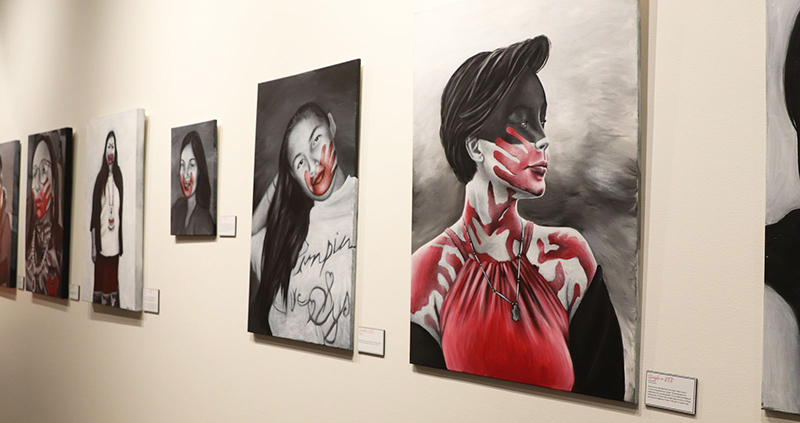
By Wade Sheldon, Tulalip News
A red handprint—bold, defiant, and highly symbolic—has become a clear cry for justice in Indigenous communities across North America. What began as a young girl’s silent protest at a track meet quickly grew into a powerful emblem of the Missing and Murdered Indigenous People (MMIP) movement. Today, the red handprint represents the pain of lives lost, voices silenced, and families left with unanswered questions. It has become a call to remember, to speak out, and to demand change.
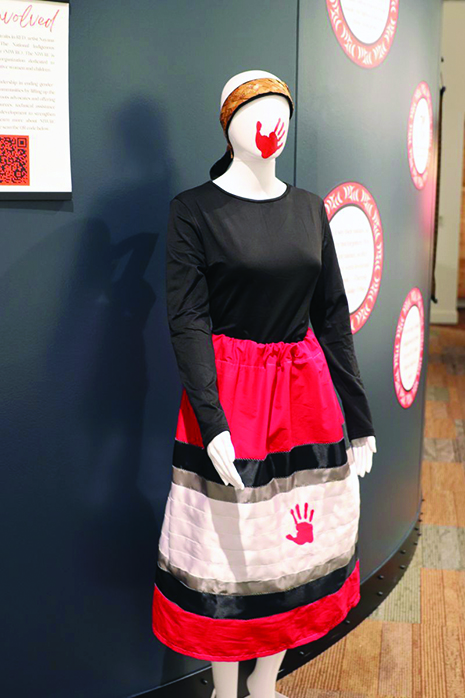
Portraits in Red, the powerful traveling art exhibit by Nayana LaFond, is now on display at the Hibulb Cultural Center in Tulalip. This installation marks its final stop in the Pacific Northwest, after previously touring through Oregon and Idaho. The exhibit opened on Thursday, June 26, and will remain available for viewing through August, though an exact closing date has not been announced. LaFond’s acrylic-on-canvas portraits depict MMIP victims and advocates with raw emotion and reverence. Many subjects are painted with a red handprint across their mouths, a striking symbol of silenced voices and the ongoing fight for justice.
The exhibit invites not just observation but participation. A reflection station set in the middle of the gallery allows visitors to write messages of strength, love, and prayer on ribbons, creating a visual tapestry of solidarity. A nearby earring display invites attendees to hang a single earring on a wire, each one representing a missing or murdered loved one. These additions provide visitors with a way to connect personally with the movement and honor those who are still unaccounted for.
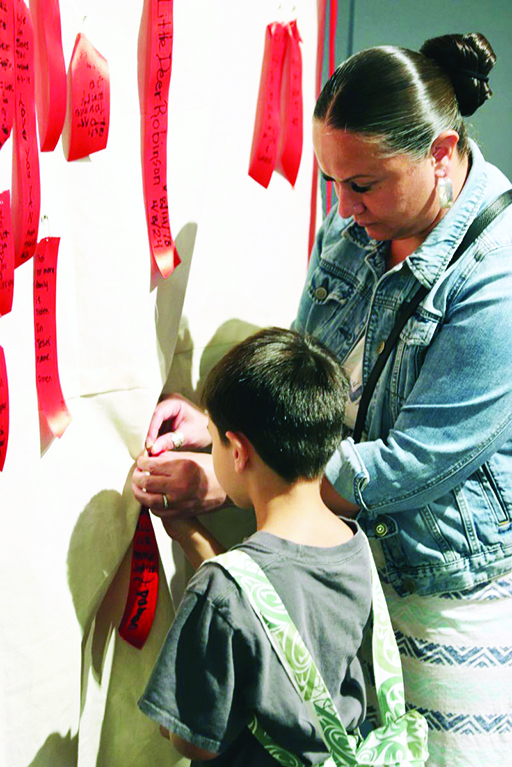
Surrounding the room are portraits of Indigenous individuals who were murdered, disappeared, or rose to prominence as advocates within the MMIP movement. Some are accompanied by short narrative stories of final sightings, painful memories, or lifelong activism. In one corner of the room, a section is dedicated to Tulalip tribal members who have become victims of the MMIP crisis, adding local resonance to the national issue.
Tulalip tribal member Neil Hamilton attended the exhibit with his daughters and reflected on the importance of sharing this history with the next generation. “I think the exhibit was informative, insightful, and brings more awareness for our community to be doing more for ourselves,” he said. “I brought my children so they could see what the red hand movement is all about.”
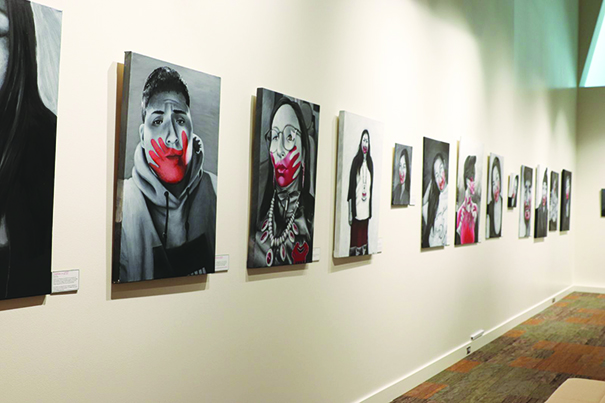
Artist Nayana LaFond, an enrolled member of the Métis Nation of Ontario, began the series in the early days of the COVID-19 pandemic. On May 5, recognized as the National Day of Awareness for Missing and Murdered Indigenous Women and Girls, she attended a virtual powwow where people shared selfies marked with red handprints. Rather than post her image, LaFond found herself reading the stories behind the photos, resonating deeply due to her own experience as a domestic violence survivor. “You don’t realize how much you connect to something until you read other people’s stories,” she said.
The first portrait she created was of Lauraina Bear from Saskatchewan. “I thought this would be the only thing I do,” she recalled. But after posting it, the response was overwhelming. She offered to paint more portraits for free, expecting a few requests, and received over 25 in one day. “I realized I couldn’t pick and choose,” LaFond said. “I had to paint them all.” Since then, she has completed more than 100 portraits, most of which were created during the first two years of the pandemic.
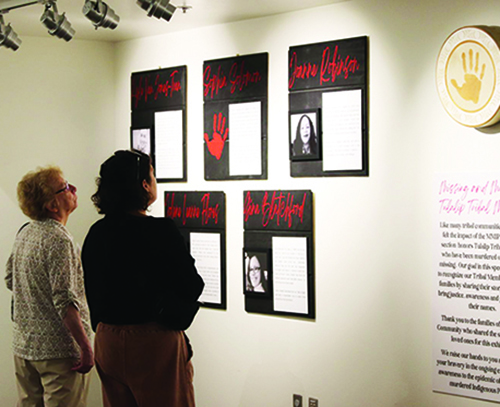
Each portrait is made in close collaboration with families or individuals, respecting their cultural beliefs and wishes. “It needed to be about each family,” she emphasized. “Not everybody wants the same thing. Some don’t want a name or likeness shared. So I always try to honor what feels right to them.”
While the project has been artistically transformative, it has also come at a deep emotional cost. “At first it was very cathartic,” LaFond said. “But after a couple of years, it started to feel like retraumatization.” The emotional toll, coupled with unauthorized uses of her artwork, led LaFond to begin winding down the project and returning completed portraits to families. “To do no harm,” she said, “I realized it was time to send them home.”
Despite these challenges, the exhibit has had a measurable impact. One painting helped bring new attention to a missing person case, leading to their recovery. The exhibit has also been used in official reports to the Canadian and Mexican governments, and was made mandatory viewing for Child Protective Services staff in Oregon. “That was huge for me,” she said. “I was grateful for that.”
Still, LaFond sees herself as one voice among many. “There are a lot of artists talking about this now, which is great,” she said. “We’re all speaking the same visual language—black and white portraits, red handprints, symbols of remembrance. It’s that collective voice that’s making real change.”
For more information, visit hibulbculturalcenter.org.
Kathryn Sue Cavender

August 25, 1962 -June 25, 2025
Kathryn Sue Cavender Kathryn Sue Cavender, 62 of Tulalip passed away June 25, 2025 in Everett.
She was born August 25, 1962 in Everett, WA to Cora Jean. She worked in finance and payroll at the Tulalip Casino and was a bingo caller. Some of the things she enjoyed were her beading, raising her puppies, making dream catchers, and spending time with her family especially her grandkidsI
She is survived by her children, David, Michael, Josh, Ashley, Deanne, and Trevor; 11 grandchildren and three great-grandchildren. She was preceded by her mother, Cora Jean; adopted parents, Alice and Jess Cavender, her daughter Jennifer, son JD.
An evening service will be held Tuesday, July 1, 2025 at 6 PM at the Tulalip Gathering Hall. Funeral services will be held Wednesday, July 2, 2025 at 10 AM at the Tulalip Gathering Hall with burial to follow at Mission Beach Cemetery.
June 28, 2025 syəcəb
Please use the following link to download the June 28, 2025 issue of the syəcəb
Kenneth Alan Joseph

AUGUST 12, 1954 – JUNE 23, 2025
Kenneth “KJ” Alan Joseph, a beloved father, grandfather, brother, uncle, and proud Tulalip Tribal member, passed away on June 23, 2025, at the age of 70. He left this world surrounded by the love of his family.
Born in Everett, Washington to Loretta James and Harold Eugene Joseph, KJ was the cherished baby brother in a big, loving family. His roots ran deep—descended from grandparents Lottie Mabel Sampson Henry and Leroy Henry Sr., and Eugene Joseph and Minnie Meander—his life reflected the love, resilience, and humor passed down from his ancestors.
He graduated from Marysville High School, blasting KC & The Sunshine Band and The Beatles. During those years, he journeyed to Hawaiʻi and fell in love with Aloha and he embraced a carefree “hippie life”. His siblings remember their childhood summers with great joy—riding bikes they pieced together from spare parts, swimming all day down at Coy’s dock, camping at Spee-bi-dah during the beach seining days, and laughing until their stomachs hurt.
KJ wore many hats in his life—blackjack dealer, Boeing riveter, carpenter, fisherman, gillnetter skipper, logger, and longtime Tulalip Tribes employee. He served in the Utilities Department, Maintenance Department, and on the Funeral Crew, offering care and service to his community.
He loved to carve cedar, always preferring the raw, unfinished beauty of the wood. He made bentwood boxes, rattles, furniture, and necklaces—things with meaning, made with care, and often given away. He had a green thumb—each year his garden overflowed with tomatoes, potatoes, and sometimes the tallest Mary Jane you’ve ever seen. He was a cook to remember—his frybread was sweet and golden, his chicken strips the best, his chili a comfort, and his strawberry freezer jam unforgettable. His smoked salmon was legendary.
He loved murder mysteries—Dean Koontz and James Patterson were his favorites—and could read three books in a week. And he loved his teams—the Seahawks, the Mariners, and the Sonics—with fierce loyalty. If there was a game on, you could find him watching it with his brother LeRoy, Uncle Stubby, Hanford, Gordy Hawk, or one of his many nephews.
KJ was a proud girl dad. He loved his daughters deeply, and he told them so every time he saw them. He also showed his love through the handmade gifts he adorned them with. His walls were covered with photos of his kids and grandkids—every picture ever given to him, hung with pride like a shrine. He was proud of Jessica’s accomplishments, and he carried that pride close. Chena, his oldest, lived with him and cared for him—she was his steady presence. And he loved his baby girl, Matika, in a way that will never leave her.
His daughters and grandchildren meant the world to him—Dominick, Lukas Alan, Alma Bee, and Kaya Rose. But nothing—nothing—mattered more to KJ than his grandson, “Dom”. The two were inseparable. They watched games together on weekends, talked almost every day, and stood by each other through everything. Dominick was his best friend, his joy, his steady companion—and he was with him at the very end.
He was human. He was complicated. He made mistakes. He carried pain. He also carried love—big, deep, unmistakable love for his kids and grandkids. And even when it was hard, we always knew who he was to us: our dad. Our grandpa. Our brother. Our uncle. Our stubborn, funny, story-filled, deeply loved KJ.
We like to imagine KJ now reunited with his beloved mom, Loretta; his nephews, Michael Lee and Scheiyenne Anthony; and of course, his dog, Ennit. Maybe there’s a game on. Maybe salmon on the smoker. Maybe he’s got a cedar carving in one hand and a book in the other. However it looks, we know it’s peaceful. And we know he’s home.
KJ is survived by his daughters, Chena Joseph, Jessica Joseph, and Matika Wilbur (Lino Manansala); his grandchildren, Dominick (Quinna) Joseph, Lukas Williams, Alma Bee, and Kaya Rose Manansala Wilbur; and his siblings: Marie (Gene) Zackuse, JuJu (Dolly) Joseph, LeRoy (Judy) Joseph, Karen (Cy) Fryberg, Judy (Tony) Gobin, and Carmen (John) Burke. He leaves behind a wide circle of nieces, nephews, cousins, relatives, and friends who will carry his memory forward with love.
A prayer service will be held Thursday, June 26, 2025, at the Tulalip Gathering Hall—dinner at 5pm, service at 6pm. Funeral services will follow on Friday, June 27, at 10am, also at the Tulalip Gathering Hall.
Bring your stories. Bring your laughter. Bring your love. That’s what he would’ve wanted.
A memorial service for Larry will be held on July 17, 2025 at 1:00 pm at Schaefer-Shipman Funeral Home, , with refreshments to follow. Donations in lieu of flowers to the Northwest Parkinson’s Foundation.
Rapid crisis response for Tulalip
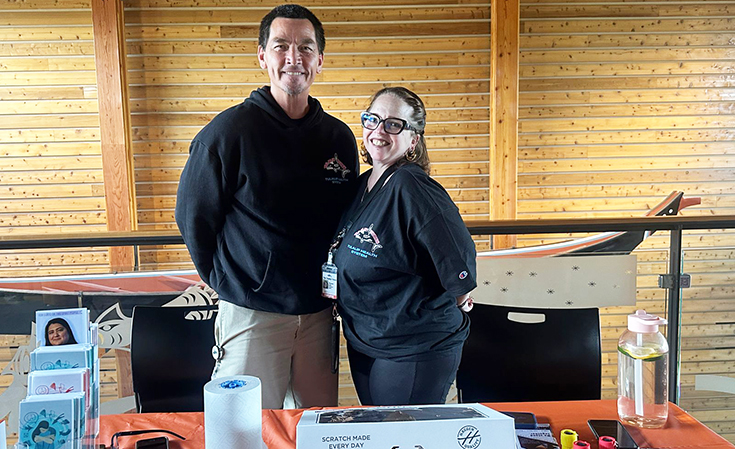
community meet and greet at the Tulalip Admin Building.
By Wade Sheldon, Tulalip News
Launched in April 2024, the Mobile Rapid Response Crisis Team (MRRCT) was created to serve the Tulalip community with timely, culturally responsive behavioral health crisis intervention. The team operates out of Tulalip Family Services. It is available to respond to both mental health emergencies and crises that may not be life-threatening but are still deeply distressing to those experiencing them.
MRRCT includes certified peer counselors, interns working toward licensure, and leadership from Rochelle Long, a Designated Crisis Responder (DCR) and Licensed Mental Health Counselor. As a DCR, Rochelle has the authority to involuntarily commit individuals who are deemed a danger to themselves or others, ensuring immediate safety and stabilization when needed.
Certified peer counselor Michael Stewart explained the team’s mission and the types of situations they respond to. “For crisis, it’s up to the individual—car accidents, death, trouble with family. Whatever you say is a crisis for you is what we are here to support,” he said. “We’re kind of like a bridge to Family Services. If someone doesn’t want to talk right away, we let them know they can come down to start the healing process. We stay with them until they get connected to a counselor.”
The team responds to calls both in person and over the phone. In-person services are available Monday through Friday, 9:30 a.m. to 8:00 p.m., with 24/7 support available via phone. “One of the team members has the phone at all times,” Stewart said. “I was on the phone at 4:50 a.m. the other day with someone in a struggle. We talked through a lot and started helping that individual.”
In the event of a mental health emergency—defined as a life-threatening situation where someone is an immediate danger to themselves or others—the Tulalip Police Department (TPD) should be called at 360-716-9911. For non-life-threatening mental health crises, MRRCT can be reached at 360-502-3365. Community members can also call 988 and select Option 4 for the Native and Strong Lifeline.
According to MRRCT’s program materials, a crisis is when thoughts, feelings, or actions prevent a person from engaging in everyday activities. It can feel overwhelming and may seem like familiar coping skills are no longer working. Crises can happen to anyone, even those without a formal mental health diagnosis.
Examples of when to call MRRCT:
- Suicidal thoughts, with or without a plan or access to weapons
- Homicidal thoughts, with or without a plan or access to weapons
- Active psychosis, including panic attacks or manic behavior
- Voluntary psychiatric hospitalization assistance
- Clinically significant mental health scores, such as moderate to severe PHQ-9/BDI
- Behavioral disruptions at school that prompt police or crisis intervention
- Older adults with dementia symptoms or wandering behaviors
- Frequent 911 callers suspected of having behavioral health needs
- Death or traumatic events, when the family or community requests support
- Suspicious activity calls, where MRRCT can help calm distressed individuals while TPD investigates
- Car accidents, when TPD requests help with de-escalating emotional responses
MRRCT also coordinates detox referrals and support for substance use-related crises in partnership with Tulalip’s Substance Use Disorder (SUD) department, which operates a 24/7 line at 425-754-2535.
The team’s flexibility and reach enable them to respond to a wide variety of situations, from de-escalating an emotional response at a car crash scene to assisting someone in completing a mental health packet and initiating therapy. Their role is not just crisis intervention but walking with individuals through their recovery journey until they are safely connected to the care they need.
Welcoming yubəč

By Wade Sheldon, Tulalip News
Despite a steady breeze and rain throughout the day, the Tulalip Tribes gathered in powerful unity on Saturday, June 21, to welcome the return of the first king salmon to Tulalip Bay. The annual Salmon Ceremony, held at the Tulalip Longhouse, brought together generations of tribal members, clad in traditional regalia and cedar hats, in a vibrant display of cultural pride and ancestral reverence.
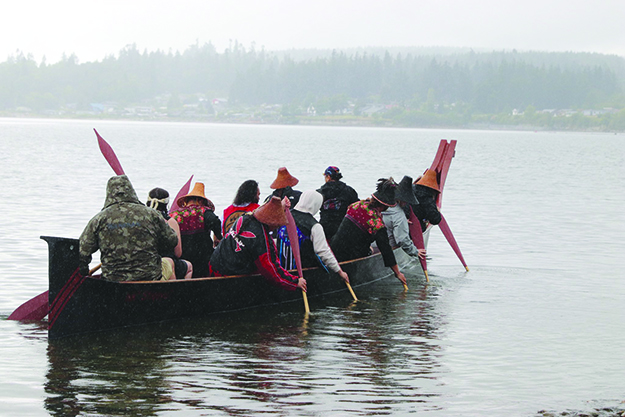

This year’s ceremony was dedicated to the memory of Mason D. Morisset, the Tribes’ longtime fishing rights attorney. Morisset spent more than 50 years fighting to protect tribal fishing grounds through natural resource litigation, winning multiple victories in the U.S. Supreme Court. He worked tirelessly on behalf of tribes across the country to uphold treaty-reserved rights to water, hunting, and fishing. As he once stated, “By law, treaties must be interpreted in favor of the Indians.”
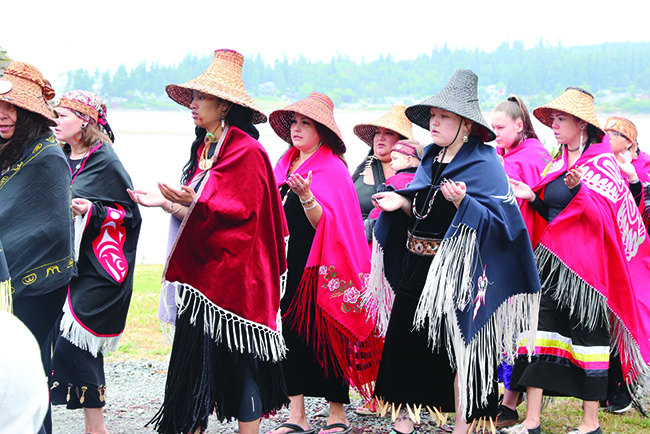
Led by Tulalip Board of Directors Glen Gobin, the ceremony honored the return of the salmon, referred to as “yubəč” the first of the season, and the scout for his people. The fish is welcomed ashore in a traditional canoe and carried to the longhouse on a bed of cedar boughs, where songs, dances, and blessings are shared in its honor.
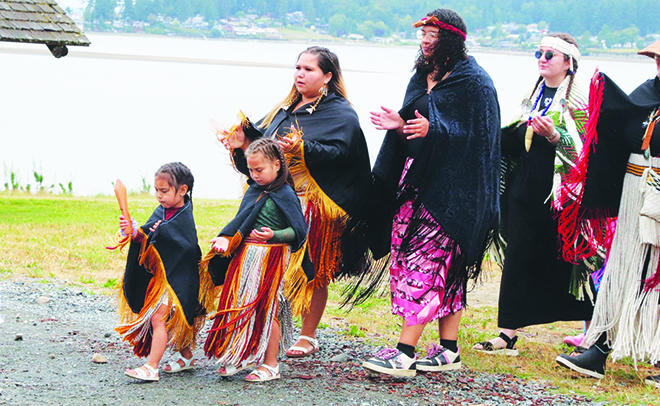
“We are the salmon people,” Glen said. “Today we’re doing this as a people, as a tribe, as a community—honoring and respecting our visitor.” He reflected on how the Salmon Ceremony had nearly been lost due to government efforts to suppress Native traditions, and how it was revived in 1976 by the revered elder Harriet Shelton Dover, alongside other Tulalip elders. The songs and structure were preserved by Stanley G. Jones Sr., who recorded and transcribed the ceremony. Along with Bernie Gobin, the two led the ceremony for many years, ensuring the teachings could be passed down to future generations.

“Before we revived the Salmon Ceremony, it was always a family thing,” Glen explained. “Always a family salmon bake, we’d get everybody together and share the blessing. What we thought was almost lost was being done individually, as a family. Now we do it together.”
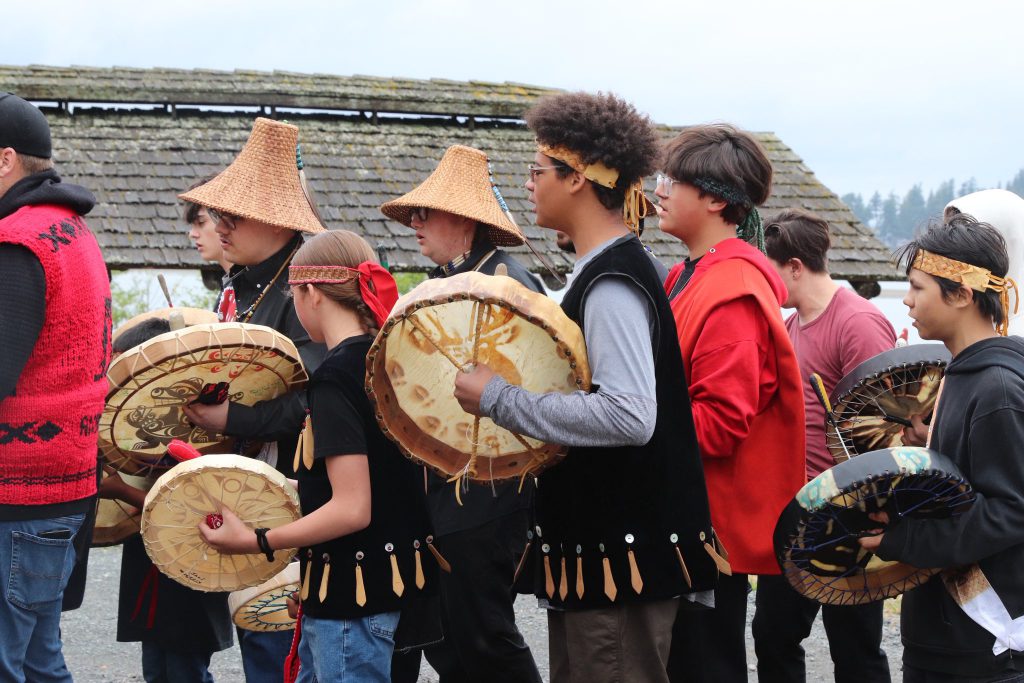
Following the blessing and ceremony at the longhouse, the celebration moved to the Don Hatch Youth Center for a communal feast, where salmon was shared among the people. Afterward, the remains of the visitor were returned to the water on cedar branches, so the salmon could carry word back to his people of the respect he received.
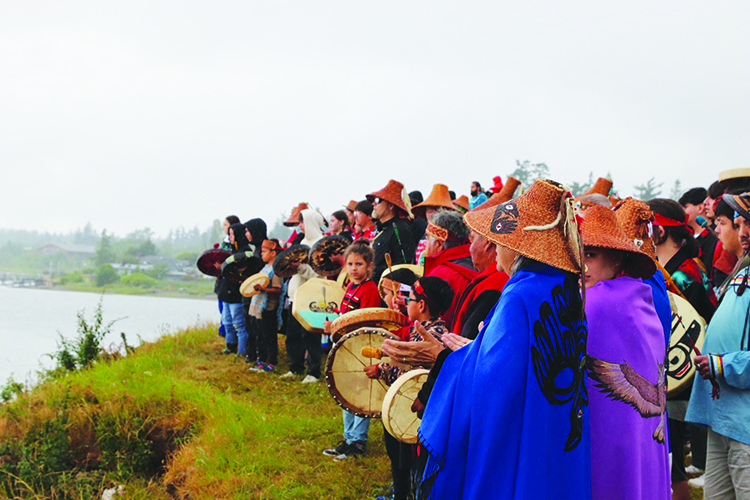
The event saw a remarkable turnout, with hundreds in attendance to witness and participate. Among them was Tulalip tribal member Cam Reyes, who took pride in sharing the day with his family. “It was an excellent event,” Cam said. “It makes me feel really proud to be able to represent and carry on and honor traditions with my family.”
As voices rang out in song and the scent of cedar filled the longhouse, it was clear that the spirit of the ceremony—and the values it teaches—continue to thrive in Tulalip. The return of yubəč each year is more than just a sign of seasonal change; it is a call to remember, respect, and protect the natural gifts that sustain the people.
Children of the Salmon get a taste of tradition
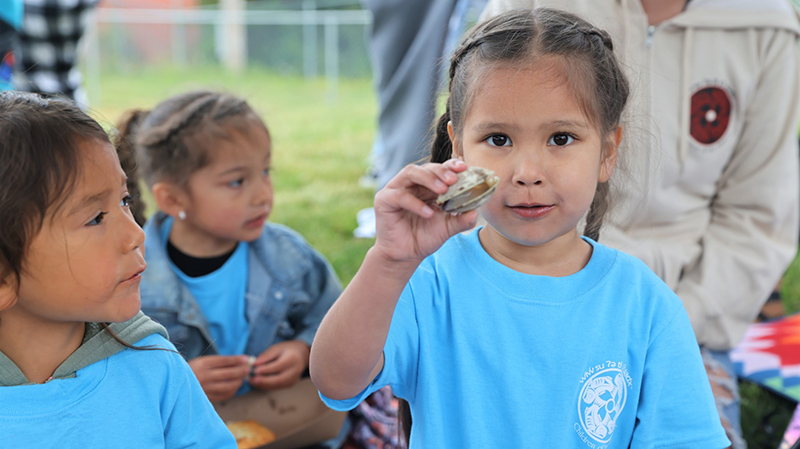
By Micheal Rios, Tulalip News
Giggles galore and the sweet scent of thimbleberries filled the air as the Tulalip Early Learning Academy (TELA) hosted its 4th annual clam bake for this generation’s youngest learners. Nestled a mere block away from the Tulalip Bay shoreline, outside a recently built mock longhouse on TELA’s campus, the academy’s Children of the Salmon got a taste of traditional Coast Salish lifeways.
Designed as a hands-on experience to introduce toddlers and preschoolers to their Coast Salish heritage, the clam bake brought together tribal educators, elders, and families in a memorable celebration of food, identity, and tradition.
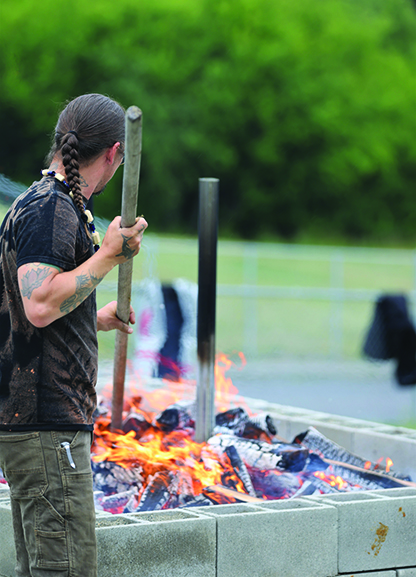
“Today, we just live on a tiny portion of territory, 22,000 square acres, compared to the millions of acres our ancestors controlled pre-treaty. Our leaders of the time signed the treaty, ceding those millions of acres in order to reserve the rights to fish and hunt and gather in our traditional area,” explained Tulalip elder and cultural historian, Ray Fryberg. “Our people used to live all along the water and traveled from village to village via canoe.
“Their paddles were made hard enough and with tips that they would use to dig into the beach and gather clams. They’d take the rocks, heat them up, and create steam to cook those clams. That was our ancestor’s version fast food. They’d use the natural elements of fire, water, and steam to cook their food and nourish their bodies on the go.
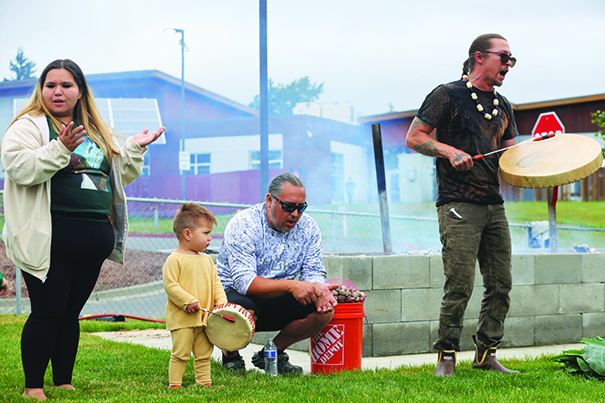
“They didn’t have seasonings, like the salt and pepper, that we have today. Instead, they used locally harvested sprouts to season their food. Today, we’ll be using skunk cabbage leaves and thimbleberry leaves to season the clams. You might smell a sweet aroma from the fire pit. That’s the thimbleberry seasoning the clams.
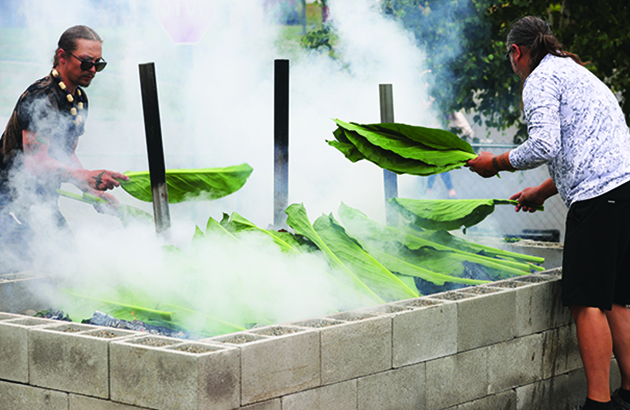
“And so, we’re going to have this clam bake, in a similar way that our ancestors used to cook their food when they traveled in canoes,” continued the venerable elder. “These are our first foods and these are our medicines to keep our bodies healthy. This is what we mean by traditional teachings and we don’t want to let these things get away.”
TELA’s mission to immerse its Children of the Salmon in culturally rich activities and develop strong cultural values and traditions was on full display. This includes the priority to make it completely normal to hear Tulalip’s ancestral language of Lushootseed spoken every day via word learning, fun activities and story time.
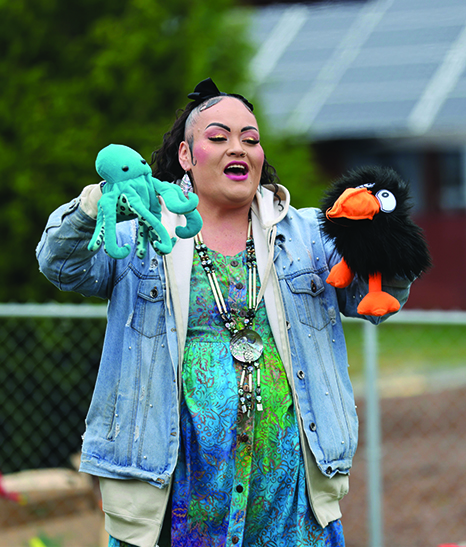
In keeping with teachings from a traditional clam bake, in which Lushootseed would’ve been the primary language, the Tribe’s Language Warriors were on-site sharing songs that many of the kids knew word for word. There were even a few traditional stories shared that kept the children’s attention while the clams were being prepared.
“Here at TELA, our teaching model is rooted in our traditional ways,” said TELA Director Sheryl Fryberg as she watched the anticipation and excitement grow from her Children of the Salmon. “Our teachings aren’t confined to a classroom or a particular book that says you have to remember this or that. Instead, our teachings are taught by active participation and learned experience.

“How do these experiences, like from his clam bake for example, make our children feel? We want them to feel this experience in their spirit so they have confidence and pride in who they are, always,” continued Sheryl. “We understand that as they grow older, they may move away from Tulalip. But having these good, welcoming cultural experiences as a child, they’ll know that Tulalip will always be here for them and for their future children. It’s about planting the seeds so the roots grow.”
Several students couldn’t help but make their way as close as possible to the fire pit, where they watched with wide-eyed wonder as the clams were prepared and placed over hot rocks layered with wet seaweed and large skunk cabbage leaves, and then steamed the old-fashioned way.
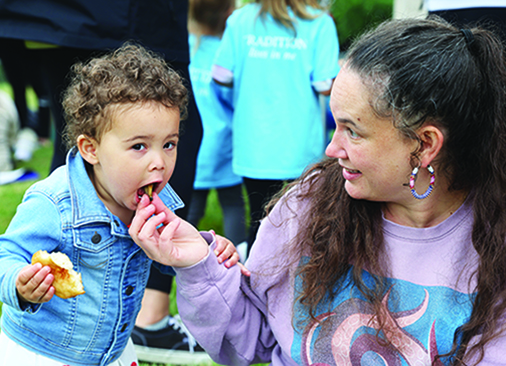
After nearly 20 minutes of steaming and being seasoned in sweet thimbleberry, the clams were ready to eat. The Academy’s students lined up and one by one were served a heaping ladle’s worth of oceanic deliciousness. For some of the students, it was there first time ever eating clams. For others, it was just another day at an all-you-can-eat seafood line. In either case, the clam bake successfully served as an extension of its primary mission by bringing abstract ideas like cultural identifyand traditional teachings into a very tangible and very tasty form.
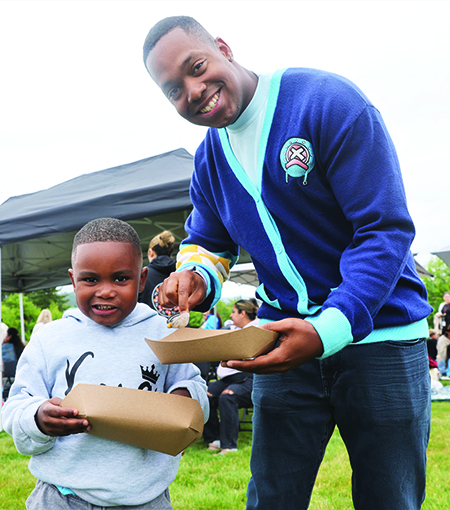
“This right here is everything,” said Lushootseed Language Warrior and lifetime fisherman Thomas Williams, smiling as he watched the children devour their traditional food. Together, with his brother Andy, they manned the fire pit and ensured the clams were steamed to perfection. “When we were growing up, the excitement with food was getting a McDonald’s Happy Meal. Now, here we are, getting that same reaction from kids today with our traditional foods.
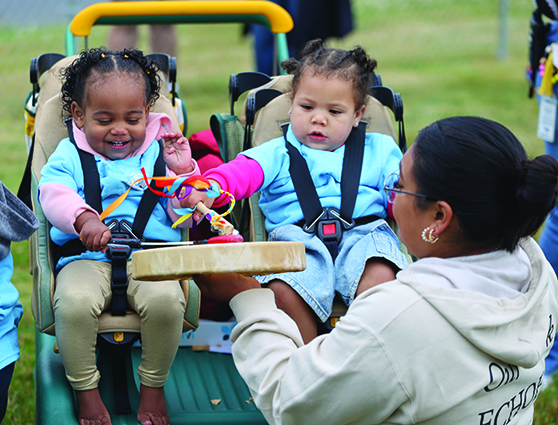
“We hear concepts like food sovereignty, but what does that really mean? For us and these kids, it’s about gathering and harvesting our traditional foods without having to purchase them from a store,” he added. “In order for them to want to learn to gather and harvest, or hunt and fish, they have to like traditional foods, which means introducing them to these foods at an early age. Just look around. Seeing these kids eat these clams and run back into line for more is so encouraging. I’m sure there are future fisherman here. They may not remember this specific moment when they are adults, but they’ll know they like the taste of clams and they’ll embrace that knowledge by harvesting clams or crab or geoduck to feed themselves and their family.”
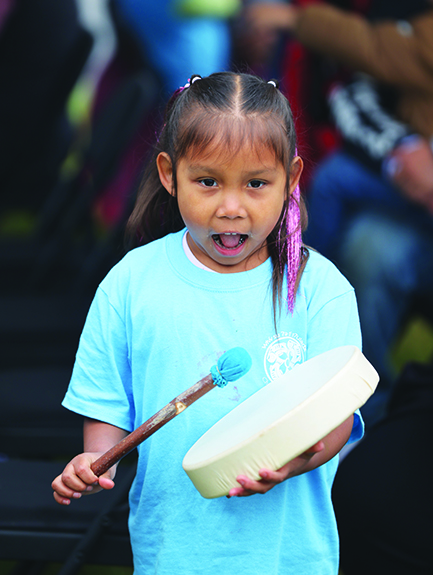
Planting the seeds early so our Tribe’s children embrace tradition and grow to know who they are and where they come from are ideals both TELA and Lushootseed strive to impart onto the greater Tulalip community. If the clam bake’s success shows us anything, it’s that sometimes all it takes is a taste to ensure tradition lives on.